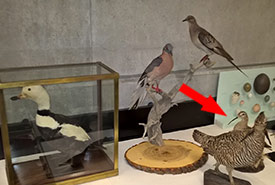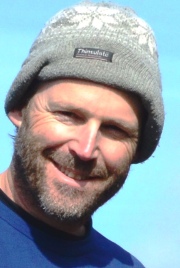Obituary for a curlew

An Eskimo curlew taxidermy is likely the only way to see this species in the flesh nowadays. (Photo taken at the Royal Ontario Museum by Dan Kraus/NCC staff)
It’s probably unusual to think about writing an obituary for a bird. But the story of the Eskimo curlew recently led me to do just that:
Eskimo curlew (Numenius borealis), after a long battle with market hunting and habitat loss, passed away sometime in the last generation. Last documented 55 years ago on September 4, 1963, in Barbados. A shorebird born on the high tundra in Canada, Eskimo curlew flew to Argentina each winter.
Cousin of Asian little curlew of Siberia and Australia, long-billed curlew of North and Central America and whimbrel (summering throughout northern North America Europe and Asia), she is (likely) predeceased by her cousin, the slender-billed curlew of Siberia and the Mediterranean.
Eskimo curlew will be remembered for her once awe-inspiring abundance, amazing migrations and, in our reflections of loss, what could have been saved.
Visitation will held this September on the barrens of Labrador where, during fall migration, she would feast on crowberries (locally still named curlew berries in her memory). A second visitation will be held during April in the grasslands of southern Manitoba where her flocks would stop each year to feed on grasshoppers and where she was often called the prairie pigeon.
She will be missed by the future generations that will never know her, and our Canadian barrens, prairies and coasts that will eternally await her return.
Special thank you to the many ornithologists and dedicated birders that faithfully kept watch for her return, and to those who still hold hope. Memorials can be made by protecting habitat for shorebirds, and a commitment that this will be the last bird that forever falls from our skies.
There’s a bird I once dreamed of seeing. In the early 1990s, I was a student working at Point Pelee National Park, a birder’s paradise. I remember scanning the Tip (the southernmost point in Canada) looking at shorebirds, hoping one might be the elusive Eskimo curlew.
I don’t dream of seeing an Eskimo curlew anymore. The last confirmed record was 55 years ago today, on September 4, 1963, when one was shot in Barbados. There have been a handful of hopeful observations since, but nothing confirmed. Nothing for a long time. Eskimo curlew are, in all likelihood, extinct. We’ve been calling it endangered for decades, but perhaps it’s now time to confess its extinction to this generation.
The Eskimo curlew was a small, grayish-brown shorebird with feathers that were spotted and outlined with a brown buff. Like all curlews, it had long legs and a long, slightly curved bill. It was about the size of a pigeon.
Average in appearance, but magnificent in migration. Its only documented nesting areas were in the northern Northwest Territories, although it may also have summered in parts of Alaska. There, the birds would spread out across the barrens, lay four eggs in a shallow depression scraped from the ground and raise their chicks. In summer and fall, depending on their age, they began to flock and migrate to the east. Most were destined for Labrador, where they would congregate in the open heathlands. There, they fattened up on insects, blueberries and bearberries, but their main food was crowberries.
Crowberries are a low evergreen shrub with black berries, and were so closely associated with the Eskimo curlew, that the plant is still called the curlew berry in parts of Labrador.
Most flocks departed directly from Labrador and other heathlands along the coast as far south as New England for what was likely a non-stop flight to South America. After landfall, they followed river valleys to the southeastern coasts and grasslands of Argentina and Uruguay. An amazing southward migration of over 15,000 kilometres, fueled by crowberries.
In March and April, the Eskimo curlew began its northward migration. But this time, most flocks flew through the Great Plains. They searched out areas that had been recently burned, heavily grazed by plains bison or stripped near-bare by the biblical swarms of Rocky Mountain locusts that once occurred. After feeding, they would continue north, back to the barrens.
What was perhaps most spectacular about this bird was its astonishing abundance. We don’t know how many Eskimo curlew there were, but there’s no question the flocks were vast. John Audubon likened their flocks in Labrador to those of passenger pigeons. The total population likely ranged from the high hundreds of thousands into the millions.
This species' abundance was its downfall. Many accounts exist of thousands of Eskimo curlew being shot in a single day. Known as the “dough bird,” it was a favourite of market hunters. Packed into barrels, they were destined for the meat shops of Montreal, Boston and other growing cities; our own domestic bush meat trade. At the same time, critical prairie stopover sites were being forever altered by habitat loss, fire suppression and the near extinction of plains bison.
Overharvest and habitat loss are a proven formula for extinction. By the early 1900s, the Eskimo curlew was rare. The last confirmed record was in 1963. It was one of the first species to be listed as endangered by the Committee on the Status of Endangered Wildlife in Canada. Globally, it’s assessed as critically endangered on the IUCN Red List of Threatened Species.
But it’s probably gone forever.
What’s hard to take about the extinction of the Eskimo curlew is that we were so darned close to saving it. By the early 1900s, many other birds had also declined to precipitously low numbers. The over-hunting of migratory birds and the decline of once-abundant species, such as the passenger pigeon, sparked the Migratory Bird Treaty of 1916, an agreement between the U.S. and Canada to protect birds from over-hunting. Populations of many other birds started to come back. But not the Eskimo curlew.
We can’t save the Eskimo curlew, but we can save the piping plover, buff-breasted sandpiper, semipalmated sandpiper and other shorebirds. But we need to act soon. Migratory shorebird populations in North America have declined by almost 70 per cent since 1973. The main threat is habitat loss. Today, shorebirds are not shot and packed in barrels headed to the markets of Montreal and Boston, but they die from starvation and exhaustion when suitable areas of habitat are wiped from their map.
Habitat loss is gradual and ever-present. But we know the solution. Key migratory stopover sites in Canada have been identified as Important Bird Areas. And we are making some progress. Over the last year, the Nature Conservancy of Canada has protected important shorebird stopover sites at Johnson’s Mills, New Brunswick, Buffalo Lake, Alberta and Blooming Point, PEI. These sites are protected by Canadians, businesses, provinces and with funding from the Government of Canada, under the Natural Areas Conservation Program.
But we need to do more. Our opportunity to save the Eskimo curlew has slipped away, but we still have the chance to save the diversity, abundance and magic of shorebirds and their migration for our children and grandchildren.


